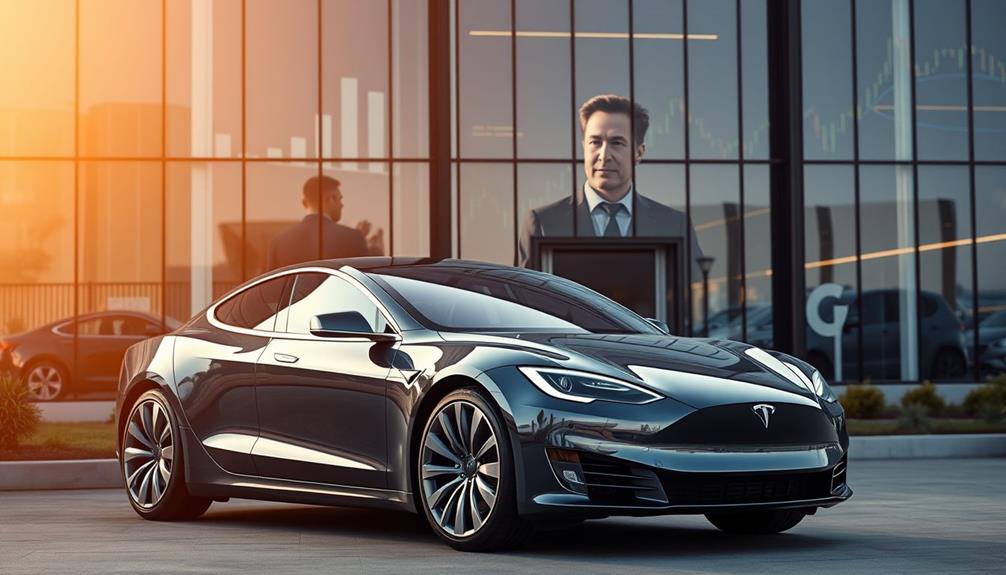You can count on Tesla batteries lasting between 8 to 15 years, making them a reliable choice for your daily driving. Many drivers see minimal capacity loss, with models like the S and X retaining about 90% after 200,000 miles. Initial degradation is usually around 5% in the first year. Factors like frequent fast charging, extreme temperatures, and aggressive driving can hasten wear, so it's wise to monitor your battery health. Plus, Tesla's warranty guarantees at least 70% capacity retention. There's more to discover about how to keep your battery performing at its best.
Key Takeaways
- Tesla batteries typically last between 8 to 15 years, with some models achieving over one million miles on the original battery.
- Model S and Model X batteries retain about 90% capacity even after 200,000 miles of use.
- Initial battery degradation is approximately 5% in the first year, followed by 5% loss per 100,000 miles.
- Regular software updates and proper charging habits can optimize battery performance and mitigate degradation.
- Tesla offers an eight-year warranty on batteries, ensuring at least 70% capacity retention during that period.
Tesla Battery Lifespan Overview

When you consider the lifespan of Tesla batteries, you'll find they're engineered for impressive longevity. On average, a Tesla battery lasts between 8 to 15 years, depending on your charging habits and driving patterns. When properly maintained and charged, some Tesla batteries have been known to last even longer than 15 years. This impressive Tesla car longevity is a testament to the quality and durability of their battery technology. With advancements in battery technology and improvements in charging infrastructure, it’s likely that the lifespan of Tesla batteries will continue to improve in the future.
For instance, the Model S and Model X batteries retain around 90% of their capacity even after 200,000 miles, showcasing remarkable battery lifespan and capacity retention.
Real-world data highlights the durability of Tesla batteries, with the 2013 Model S P85 exceeding a staggering one million miles on its original battery. Standard Range models can achieve about 300,000 miles, while Long Range models may go up to 500,000 miles before experiencing significant degradation.
Battery degradation typically starts with an initial 5% loss in the first year, followed by an average of 5% loss per 100,000 miles. This gradual decline means you can count on your Tesla battery to perform well over the years, provided you maintain good charging habits.
Factors Affecting Battery Degradation

Battery degradation is an inevitable reality that every Tesla owner must consider. Several factors can influence how quickly your battery's capacity diminishes over time. Understanding these factors can help you make informed decisions to prolong your battery's lifespan.
- Frequent fast charging can cause stress on lithium ions, accelerating degradation.
- Exposure to extreme temperatures, both hot and cold, can impact battery performance.
- Aggressive driving habits can lead to increased wear on your battery, contributing to faster degradation.
- Long periods of inactivity can result in a gradual loss of battery capacity.
Real-world data shows that batteries typically experience an initial 5% degradation within the first year, followed by about 1% annually.
Regular software updates are essential, as they optimize battery performance and may counteract some degradation effects. The aging of the battery's electrolyte and the phenomenon of lithium ions becoming stuck during charge/discharge cycles are significant contributors to the loss of battery capacity.
Warranty and Coverage Details

For many Tesla owners, understanding the warranty and coverage details is essential for peace of mind regarding their vehicle's battery.
Tesla offers an extensive Battery Warranty that lasts eight years for most models. If you own a Tesla Model S or Model X, your battery is covered for up to 150,000 miles. In contrast, the Tesla Model 3 RWD has a warranty period of eight years or 100,000 miles, while the Performance variant and Model Y are covered for eight years or 120,000 miles.
This warranty guarantees that your battery will retain at least 70% of its original capacity during the warranty period. It covers defects in materials and workmanship, with specific mileage limits that vary by model, ensuring you're protected against significant battery degradation.
If your battery can't charge to at least 70% of its original EPA range after reaching a 30% degradation threshold, a replacement may be considered.
For clarity and transparency, you can find Tesla's warranty details and coverage specifics on their official website. This way, you can make informed decisions and enjoy your Tesla experience with confidence.
Replacement Costs and Process

Replacing a Tesla battery can be a significant investment, typically ranging from $10,000 to $20,000 depending on your model and location. For example, an 85-kWh Model S pack may cost around $12,000, while a 74-kWh Model 3 pack can be approximately $10,000.
When considering battery replacement, keep these points in mind:
- Authorized service centers handle the entire process.
- Diagnostic checks are conducted before replacement to guarantee everything's functioning correctly.
- The replacement process usually takes several hours.
- Post-replacement software updates are necessary to optimize performance.
Tesla batteries come with an eight-year warranty, assuring they retain at least 70% of their original capacity during that time. This warranty provides peace of mind against significant degradation.
If your battery does need replacing, using remanufactured battery packs can help reduce replacement costs. Remember, understanding the total costs and processes involved will help you make informed decisions about your Tesla's battery health and longevity.
Tips for Monitoring Battery Health

Monitoring your Tesla's battery health is vital to maintaining its performance and longevity. As a Tesla owner, you should regularly charge your battery to 100% and compare the displayed range against the EPA-rated range. This practice helps you identify any significant battery degradation over time.
Keep an eye on the kWh used when charging from 10% to full; this gives you a clearer picture of your battery's capacity retention.
Utilizing the battery health test available in Service mode can provide an in-depth assessment of battery performance, though it may take up to 24 hours to complete. Additionally, letting your Tesla "sleep" for a few hours at various charge levels—like 30%, 40%, and 50%—can help you understand its health during different states of charge.
Tracking battery performance over time is paramount. Look for any noticeable decrease in range or efficiency, as this could signal early issues.
Being proactive in monitoring your battery health not only helps with battery management but also strengthens your position for warranty claims if necessary. Keep these tips in mind to guarantee your Tesla runs smoothly for years to come.
Frequently Asked Questions
Can You Check Battery Life on Tesla?
You can check your Tesla's battery life by charging it to 100% and comparing the range displayed with the EPA-rated range. Regularly monitoring performance and using the battery health test can also provide valuable insights.
Can You Check Battery Life on Tesla?
You can check your Tesla's battery life by charging it to 100% and comparing the range against the EPA estimate. Also, monitor performance and degradation patterns to better understand your battery's health over time.
How Many Years Are Tesla Batteries Good For?
Tesla batteries typically last around 8 to 15 years, depending on usage and model. You can expect them to retain good performance for at least 200,000 miles, ensuring reliable driving for many years ahead.
How Many Years Are Tesla Batteries Good For?
Tesla batteries typically last around 8 to 15 years, depending on usage and model. You can expect around 200,000 miles before significant degradation, with some models even surpassing one million miles with proper care.
Conclusion
So, if you're banking on your Tesla's battery lasting longer than your last relationship, you might want to check those degradation stats. Sure, it's got a warranty, but that won't help when you're stranded, contemplating life choices under a tree, waiting for a tow truck. Remember, a little battery TLC goes a long way, but don't expect it to hold a grudge—or a charge—like your ex does. Happy driving, and may your battery last longer than your patience!










